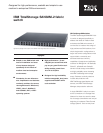
configuration can consist of one or two
Fibre Channel links to a disk storage
array or to an LTO™ tape drive. An
entry-level, 16-port storage consolida-
tion solution can support up to
15 servers with a single path to either
disk or tape. The FlexPort feature is
designed to enable a base switch to
grow to 16 ports, in eight port incre-
ments, to support more servers and
more storage devices without taking
the switch offline.
A high-availability solution can be cre-
ated with redundant switches. This
capability is ideal for server clustering
environments. Such a configuration can
support from 14 to 30 servers, each
with dual Fibre Channel adapters cross-
connected to redundant SAN32M-2
switches which are cross-connected to
a dual-controller storage system.
While the SAN32M-2 can be the foun-
dation of medium-sized SANs, it can be
configured to participate as a full mem-
ber in a tier enterprise SAN with other
members of the IBM TotalStorage SAN
m-type family. This capability helps pro-
vide investment protection as SAN
requirements evolve and grow over
time.
Simple SAN configuration
The introduction of large capacity, high-
availability storage systems offers new
opportunities for cost reduction through
storage consolidation and infrastruc-
ture, and management simplification. In
older environments each server
accessed its own dedicated storage
capacity using either internal disks that
were contained within the server, or
disks which were part of an external
system attached exclusively to that
server. It has become difficult to sustain
that approach as both the requirement
for storage capacity and the number of
servers has increased. Storage consoli-
dation is a fundamental objective of
infrastructure simplification and is based
on the philosophy that it is easiest to
share and manage capacity contained
in a large capacity, high-performance
and high-availability external storage
system such as provided by the
IBM TotalStorage DS4000 and DS6000
series. Fibre Channel Storage Area
Networks (SANs) were developed to
provide efficient, high-performance
access from many servers to many
storage devices.
While it is possible in small environ-
ments to direct-connect servers to
external storage systems using fibre
channel links, it is more common to
configure a SAN switch between the
servers and the storage system to
enable multiple servers to share the
same storage capacity. This simple
SAN is depicted in the following
diagram.
The SAN32M-2 was designed specifi-
cally for use as the SAN switch in this
type of configuration. It is easy to install
and easy to manage. The tan, green
and blue servers represent heteroge-
neous server types which are members
of the same SAN and share capacity of
the large disk system. The SAN32M-2
can be upgraded to 32 ports and is
future-ready to support 4 Gbps servers
and storage devices as they are intro-
duced. Its flexible design allows partici-
pation with other SAN m-type switches
in fabrics that evolve as requirements
change. And it supports advanced
functions to help enable participation in
complex fabrics including cascaded
switches and ISL trunks.
High availability SAN configuration
Many applications require continuous
operation. A common design approach
to achieve that objective is to run multi-
ple instances of the application across
a cluster of servers. When a server fails
or must be taken offline for mainte-
nance, a backup server is available to
help continue operation with a minimum
of impact. Redundant paths to data are
usually configured in a clustered server










